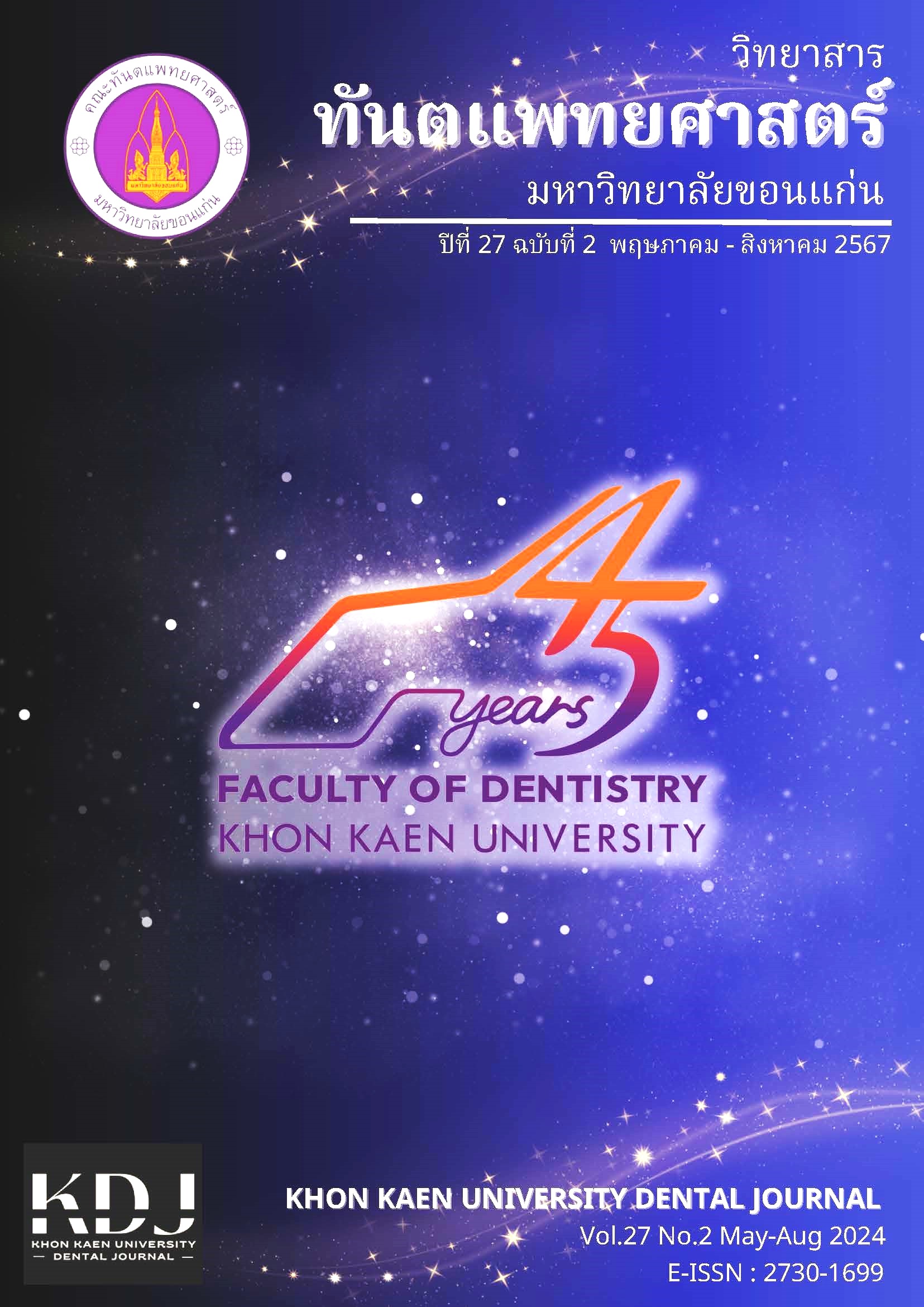Extraoral Maxillofacial Prosthesis Materials Part I: History and Silicone Elastomer
Main Article Content
Abstract
Over time, various materials have been used to create extraoral maxillofacial prostheses. Vulcanized rubber and polyurethane elastomers have certain limitations and are not popular choices for prostheses. In contrast, silicone elastomers are most used due to their softness, flexibility, smoothness, and natural skin-like staining ability. While silicone elastomers are available in various forms, some are specifically designed for maxillofacial prosthesis rehabilitation. However, despite their advantages, silicone elastomer materials have certain limitations and may not always be the best option. Therefore, a thorough study of their properties is essential to fabricate prostheses that offer the best possible outcomes for patients.
Article Details

This work is licensed under a Creative Commons Attribution-NonCommercial-NoDerivatives 4.0 International License.
บทความ ข้อมูล เนื้อหา รูปภาพ ฯลฯ ที่ได้รับการลงตีพิมพ์ในวิทยาสารทันตแพทยศาสตร์ มหาวิทยาลัยขอนแก่นถือเป็นลิขสิทธิ์เฉพาะของคณะทันตแพทยศาสตร์ มหาวิทยาลัยขอนแก่น หากบุคคลหรือหน่วยงานใดต้องการนำทั้งหมดหรือส่วนหนึ่งส่วนใดไปเผยแพร่ต่อหรือเพื่อกระทำการใด ๆ จะต้องได้รับอนุญาตเป็นลายลักษณ์อักษร จากคณะทันตแพทยศาสตร์ มหาวิทยาลัยขอนแก่นก่อนเท่านั้น
References
Heller HL, McKinstry RE. Facial Materials. In: McKinstry RE, editor. Fundamentals of Facial Prosthetics. Arlington,VA: ABI Professional Publications; 1995.
Choubisa D. A comprehensive review of extraoral maxillofacial material: Part I. Int J Dent Res Rev 2022;9(2):85-94.
Valauri AJ. Maxillofacial prosthetics. Aesthetic Plast Surg 1982;6(3):159-64.
Upham RH. Artificial noses and ears. Boston Med Sur 1901;145(19):522-3.
Kazanjian VH. Modern accomplishments in dental and facial prosthesis. J Dent Res 1932;12(5): 651-93.
Peyton FA. History of resins in dentistry. Dent Clin North Am 1975;19:211-22.
Lloyd RS, Brund RR. Maxillofacial prosthetic problems in patients with cancer. J Am Dent Assoc 1947;35(3): 162-70.
Szczepanowska PM, Akhmedovara NG. Gutta percha, natural rubber and balata-chemical characterization of polyisoprenes in the context of cultural heritage. Herit Sci 2023;11(125):1-18.
Hurley PE, History of natural rubber. J Macromol Sci A 1981;15(7):1279-87.
Cai GR. Redefining Vulcanization: Charles Goodyear, Patents, and Industrial Control, 1834-1865. Technol Cult 2010;51(2):357-87.
Hendrickson KE, Corfield JJ, Steven Laurence Danver. The encyclopedia of the industrial revolution in world history. Lanham (Md.): Rowman & Littlefield, Cop;2015.
Roberts RM. Serendipity: Accidental discoveries in science. New York John: Wiley & Sons;1989.
Jones KP, Allen PW. Historical development of the world rubber industry. In: Sethuraj MR, Mathew NM, editors. Natural Rubber: Biology, Cultivation and Technology. London: Elsevier; 1992. p.1-25.
Stephens C. A brief history of the development and use of vulcanised rubber in dentistry. Br Dent J 2023;234(8): 607-10.
Choubisa D. A comprehensive review of extraoral maxillofacial material: Part II: early extraoral maxillofacial materials. Int J Dent Res Rev 2022;9(4): 267-75.
Bykowsky MJ. Latex allergy: an emerging crisis in health care. J S C Med Assoc 1996;92(6):267-70.
Turjanmaa K, Alenius H, Mäkinen-Kiljunen S, Reunala T, Palosuo T. Natural rubber latex allergy. Allergy 1996;51(9):593-602.
Sussman GL, Beezhold DH, Kurup VP. Allergens and natural rubber proteins. J Allergy Clin Immunol 2002;110(2 Suppl):S33-9.
Yeang HY, Arif SA, Yusof F, Sunderasan E. Allergenic proteins of natural rubber latex. Methods 2002;27(1):32-45.
Ravve A. Free-Radical Chain-Growth Polymerization. In: Principles of Polymer Chemistry. 3rd ed. New York: Springer;2012. p.69-150.
Ravve A. Step-Growth Polymerization and Step-Growth Polymers. In: Principles of Polymer Chemistry. 3rd ed. New York: Springer;2012. p.403-535.
Young RJ, Lovell PA. Introduction to polymers. Boca Raton: CRC Press; 2011.
Elias HG. Macromolecules: Volume 1: Chemical Structures and Syntheses 1st ed. New York: WILEY‐VCH;2005.
Common Types of Organic Reactions- Substitution and Addition Reactions [Internet]. Unacademy. Available from:https://unacademy.com/content/jee/study-material/ chemistry/common-types-of-organic-reactions-substitution-and-addition-reactions/
de Buyl F. Silicone sealants and structural adhesives. Int J Adhes Adhes 2001;21(5):411-22.
Soloducho J, Zajac D, Spychalska K, Baluta S, Cabaj J. Conducting silicone-based polymers and their application. Molecules 2021:26(7):1-30.
Shit SC, Shah P. A review on silicone rubber. Natl Acad Sci Lett 2013;36(4):355-65.
Rochow EG. The chemistry of silicones. Sci Am 1984;179(4):50-3.
Iwamoto T. A stable bicyclic compound with two double bonds. Science 2000;290(5491):504-6.
Dvornic PR. Thermal properties of polysiloxanes. In: Jones RG, Ando W, Chojnowski J, editors. Silicon-Containing Polymers: The Science and Technology of Their Synthesis and Applications. Dordrecht: Springer; 2000. p.185-213.
Dobkowski Z, Zielecka M. Thermal analysis of the poly(siloxane)-poly(tetrafluoroethylene) coating system. J Therm Anal Calorim 2002;68:147-58.
Sidorov TA. Asymmetry of Si-O-Si bridge bond and atom groups in silicates. Russ J Inorg Chem 2007;52(4):532-42.
Cruz RLJ, Ross MT, Powell SK, Woodruff MA. Advancements in soft-tissue prosthetics part b: the chemistry of imitating life. Front Bioeng Biotechnol 2020;8:147.
Hutchinson JM. Determination of the glass transition temperature: methods correlation and structural heterogeneity. J Therm Anal Calorim 2009;98:579-89.
Rehage G, Borchard W. The thermodynamics of the glassy state. In: Haward RN, editor. The physics of glassy polymers. Barking: Applied Science Publishers;1973.p.54-107.
Ramli MR, Othman MBH, Arifin A, Ahmad Z. Cross-link network of polydimethylsiloxane via addition and condensation (RTV) mechanisms. Part I: Synthesis and thermal properties. Polym Degrad Stab 2011;96(12): 2064-70.
Gonzaga F, Yu G, Brook M. Polysiloxane elastomers via room temperature, metal-free click chemistry. Macromol 2009;42(23):9220-4.
Craig RG, Koran A, Yu R. Elastomers for maxillofacial applications. Biomater 1980;1(2):112-7.
Lai JH, Wang LL, Ko CC, DeLong RL, Hodges JS. New organosilicon maxillofacial prosthetic materials. Dent Mater 2002;18(3):281-6.
Hulterström AK, Berglund A, Ruyter IE. Wettability, water sorption and water solubility of seven silicone elastomers used for maxillofacial prostheses. J Mater Sci Mater Med 2008;19(1),225-31.
Chalian VA, Phillips RW. Materials in maxillofacial prosthetics. J Biomed Mater Res 1974;8(4 Pt 2):349-63.
Lai JH, Hodges JS. Effects of processing parameters on physical properties of the silicone maxillofacial prosthetic materials. Dent Mater 1999;15(6):450-5.
Curtis J, Colas A. Silicone biomaterials: History and chemistry. In: Ratner BD, Hoffman AS, Schoen FJ, Lemons JE, editors. Biomaterials Science: An Introduction to Materials in Medicine 2nd ed. New York: Elsevier;2004.p.80-6.
Montgomery PC, Kiat-Amnuay S. Survey of currently used materials for fabrication of extraoral maxillofacial prostheses in North America, Europe, Asia, and Australia. J Prosthodont 2010; 19(6):482-90.
Delrin [Internet]. dupont.materialdatacenter.com. [cited 2024 Jan 28]. Available from: https://dupont.materialdatacenter.com/products/datasheet/SI/Liveo%E2%84%A2%20MDX4-%204210
Mitra A, Choudhary S, Garg H, Jagadeesh HG. Maxillofacial Prosthetic Materials- An Inclination Towards Silicones. J Clin Diagn Res 2014;8(12):8-13.
Barnhart GW. A new material and technic in the art of somato-prosthesis. J Dent Res 1960;39(4):836-44.
Udagama A, Drane JB. Use of medical grade methyl urethane silane cross-linked silicone for facial prosthesis. J Prosthet Dent 1982;48(1):86-8.


